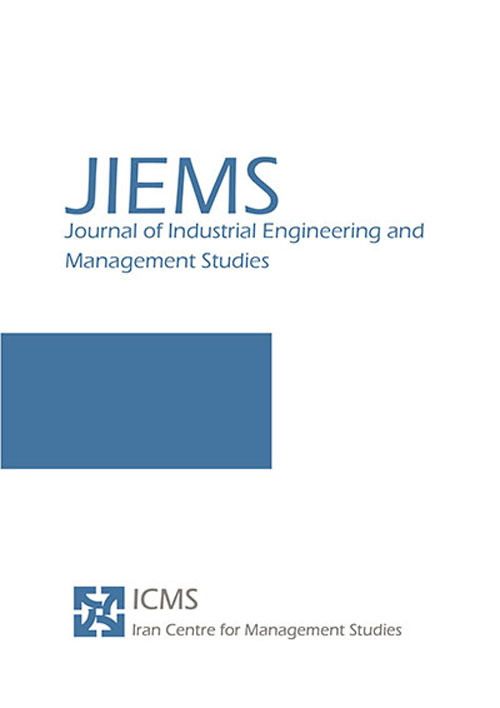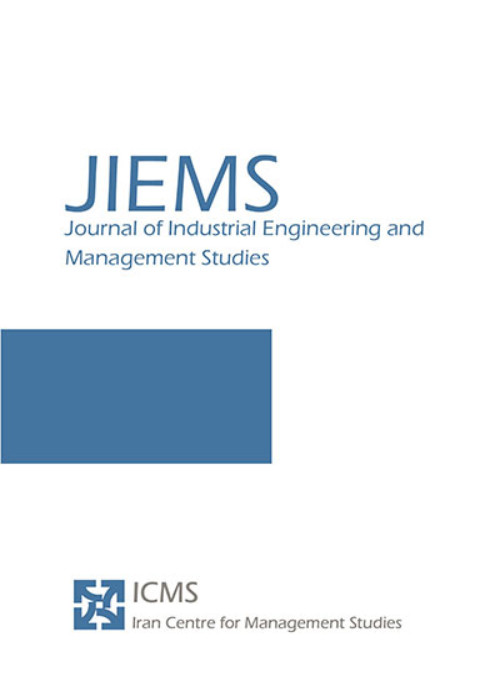فهرست مطالب

Journal of Industrial Engineering and Management Studies
Volume:2 Issue: 2, Summer-Autumn 2015
- تاریخ انتشار: 1394/10/10
- تعداد عناوین: 6
-
-
Pages 1-12Nowadays, logistics and supply chain management (SCM) is critical to compete in the current turbulent markets. In addition, in the global context, there are many uncertainties which affect on the market. One of the most important risks is supplier disruption. The first step to cope with these uncertainties is quantifying them. In this regard many researches have focused on the problem but measurement of the risk in the global SCM is yet a challenge. In the uncertain conditions, simulation is a good tool to study the system. This paper aims to study a global supply chain with related risks and measurement of the risks using simulation. Global aspects considered in the paper are: 1- currency exchange rate, 2- extended leadtime for abroad supplies, 3- regional and local uncertainties. In this regard, two popular risk measurement approaches (VaR and CVaR) are used in the simulation of uncertainties in the global supply chain. Results showed that adopting risk averse behavior to cope with the uncertainties leads to the lower stockouts and also higher costs.Keywords: Global Supply chain management, Supplier disruption, SIMULATION, Quantifying the risk
-
Pages 13-25The traveling salesman problem (TSP) is a well-known optimization problem in graph theory, as well as in operations research that has nowadays received much attention because of its practical applications in industrial and service problems. In this problem, a salesman starts to move from an arbitrary place called depot and after visits all of the nodes, finally comes back to the depot. The objective is to minimize the total distance traveled by the salesman. Because this problem is a non-deterministic polynomial (NP-hard) problem in nature, it requires a non-polynomial time complexity at runtime to produce a solution. Therefore, a reactive bone route algorithm called RBRA is used for solving the TSP in which several local search algorithms as an improved procedure are applied. This process avoids the premature convergence and makes better solutions. Computational results on several standard instances of TSP show the efficiency of the proposed algorithm compared to other meta-heuristic algorithms.Keywords: Reactive Bone Route Algorithm, Traveling Salesman Problem, local search algorithms, NP, hard Problems
-
Pages 26-42This ýpaper presents a new multi-objective fuzzy stochastic data envelopment analysis model (MOFS-DEA) under mean chance constraints and common weights to estimate the efficiency of decision making units for future financial periods of them. In the initial MOFS-DEA þmodel, the outputs and inputs are ýcharacterized by random triangular fuzzy variables with normal distribution, in which data are ýchanging sequentially. Since the initial MOFS-DEA model is a complex model, we ýconvert it to its equivalent one-objective stochastic programming by ýusing infinite-norm approach. To solve it, we design a new hybrid meta-heuristic algorithm by integrating Imperialist Competitive Algorithm and Monte Carlo simulation. Finally, this paper presents a real application of the proposed model and the designed hybrid algorithm for predicting the efficiency of five gas stations for the next two periods of them, with using real information which gathered from credible sources. The results will be compared with the Qins hybrid algorithm in terms of solution quality and runtime.Keywords: Data envelopment analysis, Random fuzzy variable, Dynamic stochastic programming, Monte Carlo simulation, Imperialist competitive algorithm
-
Pages 43-54Many supply chain problems involve optimization of various conflicting objectives. This paper formulates a green supply chain network throughout a two-stage mixed integer linear problem with uncertain demand and stochastic environmental respects level. The first objective function of the proposed model considers minimization of supply chain costs while the second objective function minimizes CO2 emission level. The Conditional Value at Risk (CVaR) approach is used to deal with the demand uncertainty in supply chain network in addition to the scenario based approach that is employed to deal with the stochastic level of CO2 emission. The implementation of the proposed model has been demonstrated using some randomly selected numbers and the results are analyzed accordingly.Keywords: Green supply chain, conditional value at risk, uncertainty, stochastic programming, robust optimization
-
Pages 55-82In todays competitive market place, companies seek an efficient structure of supply chain so as to provide customers with highest value and achieve competitive advantage. This requires a broader perspective than just the borders of an individual company during a supply chain. This paper investigates an aggregate production planning problem integrated with distribution issues in a supply chain so as to simultaneously optimize characteristics of these supply chain drivers. The main contribution of this paper is to consider the aggregate production-distribution planning (APDP) problem jointly with multiple stage, multiple product, and multiple vehicle. Moreover, we considered both routing and direct shipment as transportation system which is not considered in APDP literature so far. A mixed-integer linear programming formulation is suggested for two distinct Scenarios: (i) when we have direct shipment in which all shipments are transported directly from manufacturer to customers, and (ii) when we have routing option in which the vehicles can move through routes to deliver products to more than one customer at a trip. A numerical analysis is performed to compare performance of problem in two above Scenarios. Moreover, to assess applicability of problem, some computational experiments are implemented on small, medium and large sized problems.Keywords: Mixed, Integer Programming, Production Planning, Production, Distribution, Transportation, Vehicle Routing, Setup Times
-
Pages 83-95Game theory is the study of mathematical models and cooperation between intelligent rational decision-makers. This paper provides a flexible model to calculate pay-off matrix based on several importance factors. This model is adapted by cooperative game and developed for some competitive advantages sections in pharmaceutical industry. An optimum solution is derived by considering Nash equilibrium method for each section. Cooperative game extended for three players in a common market. Each player is looking for increase its market share with respect to participation of other competitors. Due to factors like capability of players to perform their strategic behaviors, market share adjustment by face to face comparison, the ability of any player in defined section and the importance of competitive advantage for players is basis of the calculation. A random example has been generated that the result of which led to achieve equilibrium market share for three players.Keywords: Competitive advantages, strategic behaviors, Nash equilibrium, cooperative game


